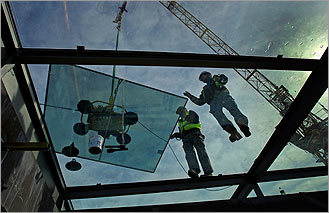In MFA wall, clues to build on
By James O'Brien, Globe Correspondent | June 24, 2009
For decades, it was a secret encased in brick and plaster, undetected by the thousands who passed by each year.
Then on June 4, a laborer working on construction of the new American Wing at the Museum of Fine Arts knocked a hole in a wall and saw an envelope sticking out of the rubble.
At first, Rick Brendemuehl thought it might be a stash of money. But instead he found a typewritten note from 1926, a letter to the future from a long-ago laborer who helped build the wall Brendemuehl was tearing down.
Thomas F. Crowley, who signed the letter, died in 1979, according to initial research, but the story of who he was has become a fascination for Maureen Melton, historian and director of the museum?s libraries and archives, who has enlisted the help of history buffs, genealogists, and archivists - as well as the power of the Internet - to piece together his story.
?I love the fact that he put it there and it could have been 1,000 years before it was discovered, or never,?? Melton said. ?And I love the idea we?ve all been walking by this wall for 83 years, without knowing it was there.??
The contents of Crowley?s letter were distinctly for the record - circumstances of the day, July 21, 1926, and details of the worksite, where it was his job to keep account of the hours worked by the construction crew.
?Today is the hottest day we have had this summer,?? Crowley wrote. It was 95 degrees.
The wages at the time? Between 74 cents and $1.50 an hour, according to Crowley?s account.
?This isn?t someone just accidentally slipping a piece of paper into a wall,?? Melton said. ?He?s thought about it. He?s telling us how much the workers make. He?s giving us a snapshot of his people. So, clearly, he?s thinking about history.??
At its simplest, the story of Thomas Crowley, at least what is known so far, is the tale of an average Bostonian, a laborer from Dorchester who lived through two world wars and the Great Depression.
For Melton, however, Crowley?s letter and his biography represent ?the story of Boston and the Museum of Fine Arts . . . and how Boston workers interacted with the institution . . . in a way that?s just completely unlike anything else.??
?It?s from and by the people who built it,?? said Melton, ?not just the donors,?? who usually get most of the credit for building museums.
With the letter in hand, Melton began her genealogical dig on June 8, assembling a team of local historians, city officials, church record-keepers, and neighborhood archivists.
She made her first find in a 1918 register of Dorchester residents that was read to her on the phone by someone from the Dorchester Historical Society. The register page listed a Mary E. Crowley at the same Dorchester address included on the letter: 107 Sawyer Ave.
Melton?s network of helpers continued to fuel her inbox with clues: a 1930 US census form and a draft registration card from 1917, both listing Thomas Crowley at the Sawyer Avenue address.
A picture began to emerge of the man who typed up and deposited the letter into the wall of the Museum of Fine Arts.
Thomas Francis Crowley was born in South Boston on June 13, 1894, according to Archdiocese of Boston records. At the time, his parents, James J. and Mary E., lived at 11 B St.
By 1917, the family had purchased the 2 1/2-story home on Sawyer Avenue.
First an auto mechanic - a relatively new trade in the 1920s - Thomas ended up, by age 32, in a desk job overseeing the workers building the Museum of Fine Arts? new wing in 1926.
At some point on July 21, the worksite perhaps becalmed with the swelter of the day, Crowley slipped his letter into an envelope, and that envelope into another, and all three into the museum wall.
?He?s sending us a message,?? said William Walczak, a historian by passion and chief executive officer of the Codman Square Health Center, who is helping Melton with her research. ?He?s a guy who lived an ordinary life, but who has opened a door to a different era.??
A breakthrough in the research came last Wednesday, when Melton found her first picture of her subject, with the help of military archivists in California.
In the photograph, Crowley sits among about two dozen fellow enlistees in the 82d Naval Construction Battalion.
Sometime after leaving the service in the mid-1940s, he married Edith M. Blake, according to Melton.
What happened between that time and the date on Crowley?s death certificate, 1979 in Fort Lauderdale, Fla., is part of what Melton continues to research.
As the project continues, Melton plans to blog her findings and make them available on the museum?s Facebook page. And she hopes to find a definitive explanation for one nagging detail - a mystery within the mystery.
The signature on the letter says Thomas F. Crowley, but the typewritten name above it reads: ?Thomas Fortune Crowley.??
The middle name is the only aberration in a search that has otherwise fit together seamlessly, the address and handwriting on the letter matching all known records written by Thomas Francis Crowley.
Perhaps, Melton speculated, Fortune was a nickname given to Crowley by others on the museum worksite, mimicking a well-known entrepreneur and philanthropist of the day, Thomas Fortune Ryan.
Whatever the reason, it slowed Melton?s initial research. But it also endeared her to the man.
?It?s funny that he would choose to put it in the letter, because the rest of the letter seems pretty historically accurate,?? she said. ?Here?s where he tortures us, and this is why I love my little Dorchester friend.??















